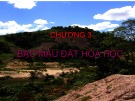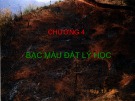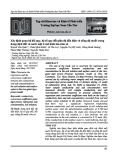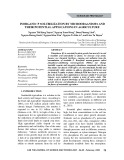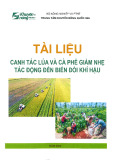
Vietnam Journal
of Agricultural
Sciences
ISSN 2588-1299
VJAS 2024; 7(2): 2110-2120
https://doi.org/10.31817/vjas.2024.7.2.02
2110
Vietnam Journal of Agricultural Sciences
Received: March 13, 2024
Accepted: June 3, 2024
Correspondence to
ttpthu@vnua.edu.vn
ORCID
Thieu Thi Phong Thu
https://orcid.org/0000-0003-0762-
0301
Ninh Thi Phip
https://orcid.org/0000-0003-1953-
9885
Nguyen Thi Thu Phuong
https://orcid.org/0009-0004-6077-
227X
Effects of Nitrogen Application Doses on the
Growth and Yield of Jiaogulan under Shading
Conditions in the Spring-Summer Season
Thieu Thi Phong Thu1*, Ninh Thi Phip1 & Nguyen Thi Thu Phuong2
1Faculty of Agronomy, Vietnam National University of Agriculture, Hanoi 131000, Vietnam
2Center for Entrepreneurship and Innovation, Hue University, Thua Thien Hue Province
530000, Vietnam
Abstract
Jiaogulan (Gynostemma pentaphyllum (Thunb.) Makino) is
distributed mostly in mountainous areas, in shaded and humid places
at 300-3200 meters above sea level. This study was conducted to
determine the appropriate application dose of nitrogen for the growth
of Jiaogulan under different shading conditions. The experiment was
arranged in a split-plot design with three replications in 2021.
Nitrogen application dose was the main factor with three levels: N1,
N2, N3 of 90, 120 and 150kg of N ha-1, respectively. The shading
condition was the sub-factor with two regimes: S1 - no shading and
S2 - 30% shading (30% reduction in solar radiation using black
netting). The observation parameters included main stem length,
number of leaves, and number of primary branches. The
physiological indicators (LAI, SPAD, dry mass) were measured at
30, 60, 90, and 120 days after transplanting. Yield and total content
of saponins and flavonoids were determined at harvesting time. The
results showed that the application of the 30% shading condition
combined with increasing nitrogen application doses had positive
effects on the growth and yield of Jiaogulan. The highest yield was
obtained in the treatment combining the 30% shading condition and
N3 nitrogen application level. The total flavonoid and total saponin
contents did not significantly differ among the treatments. Thus, in
the spring-summer season, a combination of a 30% shading condition
and nitrogen application of 150 kg N ha-1 should be applied to
produce good growth and high yield as well as ensuring the quality
of Jiaogulan.
Keywords
Jiaogulan, nitrogen fertilizer, shade, yield, quality
Introduction
Gynostemma pentaphyllum (Thunb.) Makino is a perennial
climbing plant belonging to the Cucurbitaceae family (China
Pharmaceutical University, 1996). This crop is also known by other

Thieu Thi Phong Thu et al. (2024)
https://vjas.vnua.edu.vn/
2111
names including Jiaogulan, Qi Ye Dan, Gong
Luo Guo Di, Pian Di Sheng Gen, Xiao Ku Yao,
Amachazuru, and Penta (Valentina et al., 2005).
Jiaogulan is a medicinal herb with great
therapeutic effects on many diseases such as
inflammation, hepatitis, cancer, hematuria,
pharyngeal edema, and trauma (Wu et al., 1998;
Blumert & Liu, 1999; Aftab et al., 2023). In
Japan, G. pentaphyllum is indicated as a
medicine with diuretic, antipyretic, anti-
inflammatory, and tonic properties (Tanner et al.,
1999; Chen, 2000). These effects are due to
Jiaogulan having many pharmacological
compounds, especially the abundance of
saponins. The biological activity of G.
pentaphyllum has been attributed to its saponins
of a dammarane nature called gypenosides or
gynosaponins (Cui et al., 1999; Aftab et al.,
2023; Nizomiddin et al., 2023; Wang et al.,
2023). Over 189 types of saponins were isolated
and identified from Jiaogulan, which are known
as gypenoside saponins (Gyps) (Li et al., 2016).
With so many great effects, Jiaogulan is used
more and more widely as a medicine, functional
food, herbal tea, and vegetable. As a result,
natural sources of this plant are being over-
exploited. Thus, research to find out the
technical measures for its expanding planting
areas as well as increasing its crop seasons to
produce enough materials for production and
consumption is essential.
G. pentaphyllum is distributed mostly in
mountainous areas, in shaded and humid places
at 300-3200 meters above sea level. In Vietnam,
G. pentaphyllum is found naturally on Fansipan
mountain, and in Lao Cai, Ha Giang, Cao Bang,
Hoa Binh, and Ninh Binh provinces (Do Tat Loi,
2004). Guo & Wang (1993) indicated the ideal
soil for Jiaogulan cultivation was a fertile sandy
loam more than 30 cm deep, rich in humus,
nitrogen, and phosphorus, and having a pH of
6.5-7.0. Jiaogulan plants prefer shady areas with
air temperatures of 15-30℃. In order to increase
the planting area, it is necessary to study
cultivation techniques to create suitable
conditions to meet the ecological requirements
and nutrient needs of Jiaogulan. The Vietnam
Red River Delta is a region with a hot and humid
tropical climate, especially in May, June, July,
and August with high radiation levels, which are
unfavorable conditions for the growth of
Jiaogulan. Shading, a technique to reduce solar
radiation, is applied to many plants that require
weak light conditions but are grown in strong
light ecological areas (Moniruzzaman et al.,
2009; Meenakshi et al., 2019; Pavithira 2022;
Hongzhi et al., 2023; Ornprapa et al., 2023).
Therefore, shading should be tested and applied
to Jiaogulan in order to grow it in the Red River
Delta ecological conditions. In addition, because
the vegetative parts of Jiaogulan are used as
medicines and dietary supplements, the
application of nitrogen fertilizers needs to be
carefully considered to ensure the content of
useful active ingredients as well as to increase
yield. Besides, many studies have shown that the
combination of shading conditions with
increased nitrogen fertilization brings beneficial
effects on the growth of agricultural crops
(Hongzhi et al., 2023; Ornprapa et al., 2023).
Most studies of Jiaogulan have focused on
extraction, chemistry, and pharmacology, while
research on fertilizer application and shading
techniques is still limited. Therefore, the present
study was conducted to determine the
appropriate application level of nitrogen and
shading conditions for the growth, yield, and
quality of Jiaogulan.
Materials and Methods
Experiment site, plant materials, and
cultivation practices
The experiment was conducted at Vietnam
National University of Agriculture in the Spring-
Summer season of 2021, in Hanoi, Vietnam
(21°0’ N, 105°55’ E). The measured initial
chemical properties of the experimental soil
included total N (0.09%), total P (0.18%), total K
(1.33%), exchangeable N (4.25 mg/100 g),
exchangeable P (50.05 mg/100 g), exchangeable
K (11.75 mg/100 g), organic matter (1.65%), and
pH 6.35. The climate in this region is tropical,
with an average annual temperature of 25.3℃
and an average annual rainfall of 1952.2 mm.
Meteorological data for the research area during
the field experiment were collected at a weather
station and are shown in Figure 1.

Effects of nitrogen application doses on the growth and yield of Jiaogulan under shading conditions
2112
Vietnam Journal of Agricultural Sciences
Note: The right vertical axis refers to the data of monthly average temperature. The left vertical axis refers to the data of monthly
sunshine hours and monthly average humidity.
Figure 1. Climatic data during the entire experiment in Hanoi, Vietnam
Five-leaf Jiaogulan seedlings were used in
this study. Seedlings were prepared in a
greenhouse on sandy soil. The planting density
was 20 plants m-². The applied doses of
fertilizers for 1ha were 2 tons of microbial
organic fertilizer, 60kg of P2O5, and 60kg of
K2O. The applied nitrogen doses were
according to the experimental treatments. The
types of fertilizers used in the experiment were
Song Gianh microbial organic fertilizer
(organic matter 15%, humic acid 2.5%, Ca
1.0%, strains of microorganisms: Bacillus
1×106 CFU/g; Azotobacter 1×106 CFU/g;
Aspergillus sp. 1×106 CFU/g), urea (46% N),
Lam Thao superphosphate (16.5% P2O5), and
potassium chloride (60% K2O). Basal
applications of the microbial organic and
phosphorous fertilizers were applied. The
amounts of the nitrogen and potassium
fertilizers were divided into two applications at
20 days and 50 days after planting.
Experimental design, treatments, and
parameters
The experiment was arranged in a split-plot
design with three replications. The experimental
main plot area was 10m2. The nitrogen
application dose was the main factor with three
levels: N1 - 90 kg of N ha-1, N2 - 120 kg of N
ha-1, and N3 - 150 kg of N ha-1. The shading
conditions were the sub-factor with two
conditions: S1 - No shading and S2 - 30%
shading. Black netting was used to provide the
30% shading condition (30% reduction in solar
radiation) and kept about 50 cm away from the
surface of the Jiaogulan canopy. The
observation parameters included the main stem
length (measured from the base to the top of the
main stem), number of leaves, and number of
primary branches (branches grown from the
main stem). The physiological traits (leaf area
index (LAI) and dry mass) were measured at 30,
60, 90, and 120 days after transplanting (DAT).
LAI (m2 of leaves m-2 of land) was determined
according to the formula: LAI= (A1* Number
of plants m-2 of land)/A2*100 where A1 is the
weight of whole fresh leaves of one plant (g)
and A2 is the mass of 1dm2 of fresh leaves (g).
The shoots were cut at 5 cm from the base and
oven-dried at 80℃ for 48h to determine the dry
mass (weight method), and saponin and
flavonoid contents. The total content of
saponins was measured by the recommended
method of the Vietnam Ministry of Health
(Vietnam Ministry of Health, 2017). The total
content of the flavonoids was determined
according to Pan Zhi Hao et al. (2012).
0
5
10
15
20
25
30
35
0
50
100
150
200
1 2 3 4 5 6 7 8 9
Month, 2021
Monthly average sunshine hours (h) Monthly average humidity (%)
Monthly average temperature (℃)

Thieu Thi Phong Thu et al. (2024)
https://vjas.vnua.edu.vn/
2113
Statistical analysis
The data were subjected to ANOVA for the
shading conditions, nitrogen application doses,
interaction of shading condition and nitrogen
application dose, and replication, using
IRRISTAT 5.0. The treatment mean differences
were analyzed using least significant differences
(LSD) at the 5% significance level.
Results
Effect of nitrogen application doses and
shading conditions on the growth
characteristics of Jiaogulan
Changes in the plant growth characteristics
of Jiaogulan due to the effects of the nitrogen
fertilizer and shading conditions are shown in
Figure 1 and Table 1. The length of the main
stem, the number of leaves, and the number of
primary branches increased rapidly in all the
treatments from 42 to 84 DAT. Under S1,
Jiaogulan gave better growth when nitrogen was
applied at N2. Under S2, the growth results of
Jiaogulan with the N2 and N3 nitrogen
applications were better than that of N1. The
application doses of nitrogen did not
significantly affect the main stem length. In
contrast, the 30% shading treatment showed a
statistically significant difference in this
parameter of Jiaogulan in comparison with the
no-shading treatment. Regarding the interaction
between doses of nitrogen application and
shading conditions, the S2N3 treatment showed
the longest main stem among the treatments.
Concerning the number of leaves, the results
show that Jiaogulan produced more leaves when
nitrogen application levels were increased.
Different shading conditions also had
significantly different effects on the number of
leaves. Under the 30% shading condition,
applying 150 kg of N ha-1 resulted in the highest
number of leaves among the treatments.
Regarding the number of primary branches, the
nitrogen application of 150 kg ha-1 gave the
highest value (11.90), followed by 120 kg N ha-1
(10.87), and finally 90kg of N ha-1 (9.27).
Note: S1 - no shading, S2 - 30% shading, N1 - 90 kg of N ha-1, N2 - 120 kg of N ha-1, and N3 - 150 kg of N ha-1.
Figure 2. Changes in the growth characteristics of Jiaogulan affected by nitrogen application doses and shading conditions
0
100
200
300
400
14 28 42 56 70 84 98 112
Days after transplanting
M a i n s t e m l e n g t h ( cm )
0
100
200
300
400
14 28 42 56 70 84 98 112
Days after transplanting
N u m b e r o f le a v e s
0
5
10
15
20
14 28 42 56 70 84 98 112
Days after transplanting
N u m b e r o f 1 s t b r a n c h e s
S1N1 S1N2 S1N3
S2N1 S2N2 S2N3

Effects of nitrogen application doses on the growth and yield of Jiaogulan under shading conditions
2114
Vietnam Journal of Agricultural Sciences
Table 1. Effects of nitrogen application doses and shading conditions on the growth of Jiaogulan
Treatments
Main stem length (cm)
Number of leaves
Number of primary branches
S1
N1
93.21cd
69.33d
6.27d
N2
116.45c
146.40c
9.00c
N3
60.77d
91.13cd
7.27d
S2
N1
265.75b
275.27b
12.27b
N2
317.16a
314.8ab
12.73b
N3
319.63a
358.93a
16.53a
Shading (S)
S1
90.14b
102.29b
7.51b
S2
300.85a
316.33a
13.84a
Nitrogen application dose (N)
N1
179.48a
172.3b
9.27c
N2
216.81a
230.60a
10.87b
N3
190.20a
225.03a
11.90a
LSD0.05(S)
51.72
92.23
2.70
LSD0.05(N)
28.39
48.05
0.91
LSD0.05(SxN)
40.14
67.95
1.28
CV%
10.90
17.20
6.40
CV% (S)
12.00
15.20
9.20
Note: Means followed by different letters in each column for the single factors (shading condition or nitrogen application dose) or
the interaction of shading condition and nitrogen application dose were significantly different in the LSD tests.
Jiaogulan gave a statistically significantly higher
number of primary branches when grown under
the 30% shading condition in comparison with
the no-shading condition. The interaction of
different application levels of nitrogen and
shading conditions also significantly affected the
number of primary branches. The combination of
30% shading and a nitrogen dose of 150 kg ha-1
gave the best effects on the number of primary
branches (16.53).
Effect of nitrogen application doses and
shading conditions on the physiological
characteristics of Jiaogulan
Effect of nitrogen application doses and
shading conditions on LAI
The data in Table 2 show that the LAI gradually
increased with growing time. It can be seen that
the 30% shading condition significantly
increased the LAI in comparison with no
shading. LAI in the 30% shading treatment was
doubled compared with that in the no shading
condition. Increasing the application dose of
nitrogen from 90 to 120 to 150 kg ha-1 also
increased the LAI from 1.80 to 3.00 to 3.24,
respectively. Statistical analysis of the
interaction effect between the nitrogen
application levels and shading conditions
indicated that increasing the application dose of
nitrogen in both the no-shading and 30% shading
conditions increased LAI. Nitrogen application
at the N3 level in the 30% shading condition gave
the highest LAI among the treatments.
Effect of nitrogen application doses and
shading conditions on the SPAD values
The results of Table 3 show that the
application doses of nitrogen and shading
conditions clearly affected the SPAD values at
120 days after planting. The SPAD value when
plants were grown under the 30% shading
condition (44.44) was higher in comparison with
the no-shading condition (38.14). Fertilizing
with increased nitrogen application doses also
increased the SPAD values; however, no
statistical differences were recorded among the
treatments. Although the interaction between
shading conditions and nitrogen application
doses had a statistically significant effect on the
SPAD values, under the 30% shading condition,
Jiaogulan did not show statistically significant





